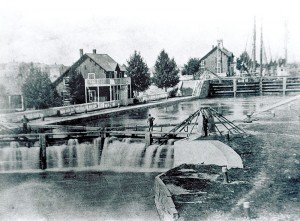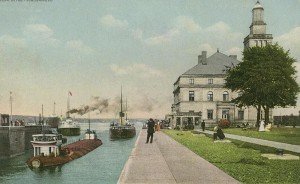The biggest event in Great lakes shipping history was the construction of the Soo Locks at Sault Ste. Marie Michigan. Just as in the case of Lake Ontario being at a higher elevation than Lake Erie, Lake Superior is at a higher elevation than Lake Huron. For commercial shipping to exist and to exist at a profit, canals and locks would have to be built connecting several of the Great Lakes.
Thank you for reading this post, don't forget to subscribe!
The first locks constructed that reached the Great Lakes was the historic Erie Canal which connected the Hudson River to Lake Erie. In fact, the Erie Canal which cut across New York state had a total of 36 locks over it’s 363 mile distance. That 363 miles covered an elevation differential of some 565 feet. That was how much higher Lake Erie was compared to the Hudson River. The Erie Canal was a great success. Not only did it make trade between the east coast and Great Lakes region much more convenient and efficient but it also opened up a gateway for immigration into what is now called the midwest. When the Erie Canal was built, the midwest of today was the western frontier. It was where immigrants, many from Europe, traveled to settle in areas such as Wisconsin, Illinois and Minnesota.
In the case of the Soo Locks, the necessity of having a way for commercial vessels to travel to and from Lake Superior was the result of iron ore being discovered and mined in the upper peninsula of Michigan. The actual discovery of iron ore predated what we refer to as the industrial age, but nevertheless, it’s value was appreciated. The iron ore was first discovered in the Marquette Range. In the early 1840’s, a man named Douglass Houghton, today’s namesake for the city of Houghton Michigan, was Michigan’s first geologist. Houghton surveyed the area and did determine that there were iron ore deposits, mostly on the southern shore of Lake Superior. At this time, the amount of the deposits were not yet determined. In 1845, the first large deposit was discovered near the site of Negaunee Michigan.

There are six main iron ore regions in the upper peninsula of Michigan extending into Wisconsin. The three Michigan ranges are the Marquette, Menominee and the Gogebic. The Gogebic extend to Wisconsin. In respect to shipping, the iron ore had to be transported from the shores of Lake Superior down to the steel mills in Ohio and Pennsylvania. The first iron ore to be shipped out of upper Michigan occurred in 1852 when six barrels of iron ore were shipped to Pennsylvania. The problem of course was the task of negotiating the rapids of the St. Marys River between Lake Superior and lake Huron to the south. During these very early times, boats would literally have to be pulled by horses through the streets of Sault Ste Marie Michigan. To make shipping possible on a large scale, Congress in 1852 passed a bill for the construction of a canal to bypass the rapids. Work began on the canal the next year. To pay for the canal and locks construction, the federal government granted the state of Michigan 750,000 acres of land to sell and raise the money.

Much of the labor for the construction was supplied by immigrants from the region south around Detroit and northern Ohio. These men found that building a canal in the upper part of Michigan would be a daunting task mostly due to the very harsh winter weather in Michigan’s upper peninsula.
The work was difficult and there were some labor disputes which caused some temporary work stoppages but finally on May 31, 1855 the first locks were completed. The locks were originally operated by the state and then turned over to federal control in the 1870’s.
The Soo Locks now consist of two canals and four locks. These allow vessels to safely travel the 21 foot drop in elevation of the St. Mary’s River between Lake Superior and Lakes Michigan and Huron.Estimates are that about 10,000 vessels go through the locks each year. These include both Great Lake and ocean vessels. Since the locks were established there have been several additions and alterations made to accommodate the modern vessels of today.
The Soo Locks today are not only a necessary aid to Great Lakes navigation but is also one of Michigan’s more popular tourist attraction. The Soo locks are closed due to ice during the winter months. The Visitors Center is open from mid May to mid October and just might be a good addition to your Michigan vacation planner. Michigan’s upper peninsula is a great place to visit during the summer months and a visit to Sault Ste Marie and the Soo Locks make a good family vacation stop. The park Visitors Center can also give you a schedule of vessel arrivals to help plan your visit. Boat tours of the locks are also available. Tour boats travel along the international shoreline of the lower harbor letting you experience all the sights, sounds, and excitement of Sault Ste Marie which is Michigan’s oldest city.
Another related article that also makes an excellent addition to your Michigan summer vacation is the Copper Country Scenic Highway in Michigan’s upper peninsula.
(Photos are from the public domain)
